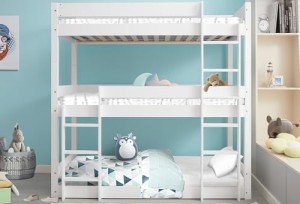This Most Common Bunks Debate Actually Isn't As Black And White As You Might Think
Bunks: The Versatile Space-Saving Solution for Modern Living
In today's fast-paced world, where city home are diminishing and the need for adaptability and practicality is increasing, bunks have become a popular service. Bunks are not simply a type of bed; they represent a sophisticated technique to taking full advantage of space, promoting social interaction, and providing comfy sleeping arrangements. This article will explore the different types of bunks available, their benefits, and how they can change both little and large home.
Comprehending Bunks: What Are They?
Bunks, frequently described as bunk beds, are two or more beds stacked on top of each other. They are designed to conserve floor space, making them perfect for kids's spaces, hostels, and even adult living situations. Bunk beds are offered in numerous designs and setups, from standard models to contemporary, designer analyses.
Types of Bunks
Type of Bunk
Description
Twin-over-Twin
Two twin beds stacked on top of each other. Perfect for kids sharing a room.
Twin-over-Full
A twin bed on top and a larger full bed on the bottom. Great for accommodating guests.
Full-over-Full
2 full-sized beds stacked together. Perfect for older children or adults.
L-Shaped Bunk Bed
Beds are organized in an L shape, permitting a corner positioning and included space beneath.
Loft Beds
Just the leading bunk is present, leaving space for a desk, sofa, or storage below.
Triple Bunk Beds
3 beds stacked vertically, excellent for maximizing vertical space.
Advantages of Using Bunks
Space Efficiency: Bunks are created to make use of vertical space, making them ideal for small bed rooms or apartment or condos where floor space is restricted.
Economical: Investing in a bunk bed can be more affordable than buying numerous separate beds, particularly for growing households or those with frequent guests.
Flexible Designs: Many bunks come with add-ons, such as desks, storage drawers, or futons, permitting versatile use of the area.
Social Interaction: Bunk beds welcome friendship amongst siblings and friends, promoting a sense of connection.
Creative Use of Space: Bunk beds motivate imagination in space design, permitting for playful styles and colorful design that can make a bedroom feel special and welcoming.
Practical Considerations
Height Limitations: When selecting a bunk bed, it is necessary to consider the height of the ceiling in the space. Procedure the space to guarantee there is adequate clearance above the top bunk for safety and comfort.
Weight Restrictions: Each bunk has a particular weight limitation. Parents ought to assess the weight of those using it, specifically in the case of adults or much heavier teenagers sharing the bed.
Security Features: Features such as guardrails, tough ladders, and security accreditations are crucial for ensuring the bunk bed's security, particularly for more youthful users.
Bunks for Various Living Situations
Household Homes
In household homes, bunks provide a useful solution for brother or sisters sharing a room or accommodating pajama parties. Bunk beds can be stylishly incorporated into a kid's space while supplying ample space for play.
Hostels and Vacation Rentals
For hostels and getaway rentals, bunk beds optimize sleeping plans without jeopardizing comfort. Such setups use a cost-efficient method to accommodate a bigger variety of guests.
College Dormitories
In college dorms, bunks assist make the most of the minimal square footage available, allowing for more room to mingle and study.
Little Apartments
In little metropolitan houses, lofted bunk beds create extra space for living locations, work areas, or storage, making life more manageable in compact environments.
Maintenance and Care of Bunks
Preserving a bunk bed is important for guaranteeing its durability. Here are a few suggestions:
Regular Inspections: Check for any loose screws or bolts and tighten them as essential.
Cleanliness: Dust and tidy the bunks frequently to prevent allergens and guarantee a clean sleeping environment.
Bed mattress Care: Use a quality bed mattress protector to preserve hygiene and extend the life of the bed mattress.
Age Appropriateness: Upgrade to a bigger, more durable bunk as kids grow or when the existing plan no longer fulfills the requirements of its residents.
Frequently Asked Questions (FAQs)
1. Are bunk beds safe for children?
Yes, bunk beds can be safe for children if they are constructed with safety functions like guardrails and a steady ladder. Constantly monitor more youthful children when they are using bunk beds.
2. What age is proper for a kid to sleep on the top bunk?
The majority of manufacturers suggest that kids under the age of six should not sleep on the upper bunk due to safety concerns.
3. How much weight can bunk beds usually hold?
Weight capacities vary based upon the style and materials but usually vary from 200 to 400 pounds. Constantly examine the manufacturer's standards.
4. Bunk Beds Store be separated into two single beds?
Many bunk beds are developed to be convertible, enabling them to be separated into two private beds. It's important to check the item specifications before acquiring.
5. What kind of bed mattress is best for a bunk bed?
A medium-firm bed mattress is frequently recommended as it provides sufficient support without being too heavy or soft, which can position security concerns.
Bunks are more than just beds. They are ingenious space-saving solutions that deal with the needs of modern-day living. With numerous designs offered, they provide comfort and performance for families, guests, and people alike. By focusing on safety and upkeep, owners can guarantee that their bunk beds end up being a cherished part of their living areas for several years to come. Whether for lively kids or accommodating visitors, bunk beds offer an elegant and practical solution to the challenge of minimal space.
